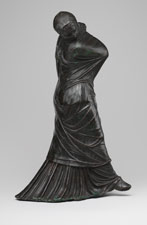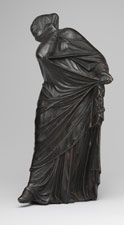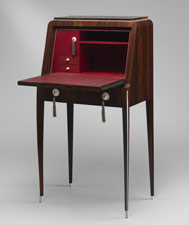New Connections appear every Wednesday. Sign up for a reminder.
 1280852
1280852 7511024
7511024 6481024
6481024 6611024
6611024 6671024
6671024 5651024
5651024 7871024
7871024 8171024
8171024 1280752
1280752 1280779
1280779 6591024
6591024 8011024
8011024 10961024
10961024 8161024
8161024 1280487
1280487 6201024
6201024 8531024
8531024 8581024
8581024 7251024
7251024 9681024
9681024 5681024
5681024 8241024
8241024 10141024
10141024 1280983
1280983 8341024
8341024 8561024
8561024 1280852
1280852
My name is Jared Goss and I'm a curator in the modern art department, and my topic is "Chic."
I see this word being used time and time again, and yet no one seems to really be able to define what it means. I think everybody
loves chic things. I think everybody has a different idea of what that word means. If you look it up in the dictionary
it is defined as, "being fashionable," and I think that's a completely useless definition.
Something from classical antiquity can be enormously chic, but yet I don't think that classical antiquity is in fashion at the moment.
Chicness is a completely subjective term, really it's a question of one's personal taste.
The Boldini portrait of Consuelo Vanderbilt, her neck is totally bizarrely proportioned, and I think that's what gives it a great deal of its stylishness. And there's an air of nonchalance about it that to me makes it chic. On the other hand
the portrait of Empress Eugenie, she's dressed up to look like Marie Antoinette. She isn't Marie Antoinette, she wants to be Marie Antoinette, it's a picture that strives, and it's sort of like Elizabeth Taylor dressed up as Cleopatra.
The Guardi is pure fantasy. No place could be as chic as the landscape here. It could only exist as an atmospheric creation.
The Canaletto is almost like a photographic recreation. There's no imagination, it's a very prosaic image.
It's all about this veneer of perfection. Inventiveness is a quality of chic. Virtuosity is often characteristic.
I think the Watteau is painted with enormous virtuosity, but it's a throwaway virtuosity, you're not aware of technique when you look at it.
Certain materials are chicer than others. Obscure materials like jasper, like alabaster
like rock crystal. And who would ever think to make
the king of the jungle out of delicate porcelain. Chic things at their best are
very understated. I particularly am drawn to classical urns. This one is especially beautiful because of its simplicity. It doesn't have athletes running all over it, but it's got this beautiful attenuated shape.
Lady's Desk by E.-J.Ruhlmann, looks like, if you actually sat down to pen a letter on it, the legs would snap off.
This is a very perverse object, it really was created solely for its decorative effect.
I'm obsessed with mythological creatures—the sphinx, the chimera, the griffin—but there's certain mythological creatures that are decidedly not chic.
Dragons, unicorns, maybe they're geek chic, I don't know. I can't explain why unicorns aren't chic, but they're just not.
Devotional objects are rarely chic. They are designed with a specific purpose in mind and as a result they really shouldn't be chic.
Cult objects are inherently chic. There's something about it that makes it have a very special and somewhat limited appeal to a certain audience.
It's a bit of an anomaly for a museum to have a room like this. It's a complete creation of the curators who put it together. Visitors who came to the Museum could look at that room and say, "This is the way our ancestors lived, wasn't it glorious, wasn't it grand," when in fact they lived in comparative squalor. I love the craziness of this totally fake vision of the past.
The Frank Lloyd Wright room is not chic, because everything about this room is founded on the basis of earnestness, truth to materials, simplicity of construction. It's in-your-face integrity.
Of course, I think everybody wants to be chic. I don't think that I necessarily want to find myself surrounded by fashion magazine portrayals of chic. It has
to be effortless. It has to be unsought. It just has to be.
And some things have it, some things haven't got it.
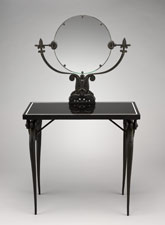 |
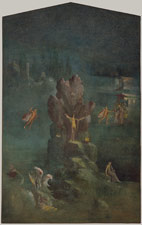 |
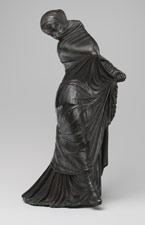 |
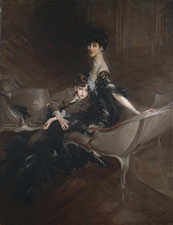 |
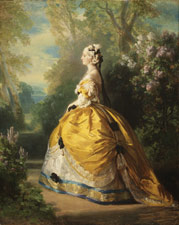 |
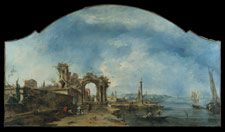 |
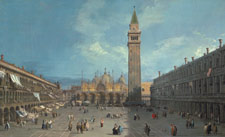 |
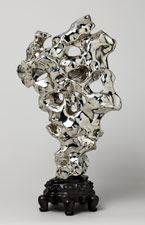 |
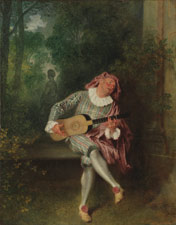 |
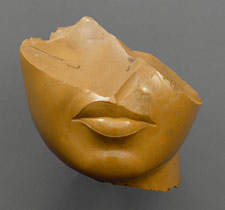 |
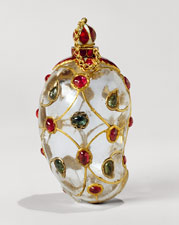 |
 |
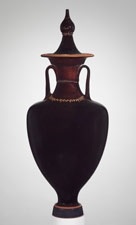 |
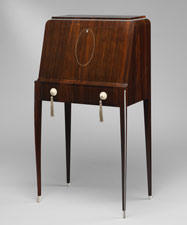 |
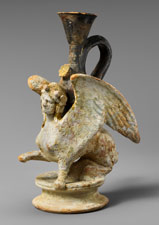 |
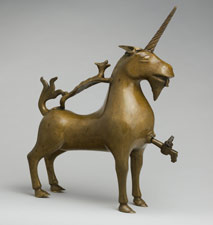 |
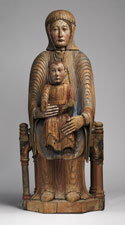 |
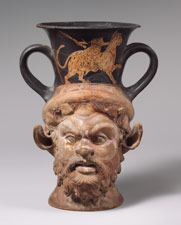 |
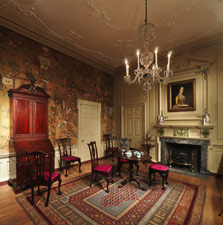 |
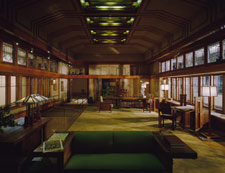 |
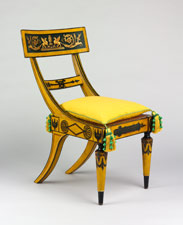 |
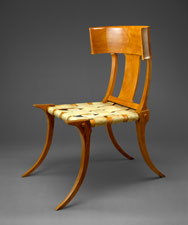 |
Works of art in order of appearanceLast Updated: June 22, 2015. Not all works of art in the Museum's collection may be on view on a particular day. For the most accurate location information, please check this page on the day of your visit. |
||
 |
Dressing table ca. 1925 Armand-Albert Rateau (French) Bronze, basalt, mirror glass Purchase, Edward C. Moore, Jr. Gift, 1925 (25.169) More information: The Collection Online Not on view
|
 Modern and Contemporary ArtSecond Floor
Modern and Contemporary ArtSecond Floor |
 |
Landscape with Perseus and Andromeda: From the "Mythological Room" of the Imperial Villa at Boscotrecase last decade of 1st century b.c.; Augustan Roman Wall painting; Fresco Rogers Fund, 1920 (20.192.16) More information: The Collection Online Not on view
|
 Greek and Roman ArtFirst Floor and Mezzanine
Greek and Roman ArtFirst Floor and Mezzanine |
 |
Statuette of a veiled and masked dancer 3rd–2nd century b.c.; Hellenistic Greek Bronze Bequest of Walter C. Baker, 1971 (1972.118.95) More information: The Collection Online Not on view
|
 Greek and Roman ArtFirst Floor and Mezzanine
Greek and Roman ArtFirst Floor and Mezzanine |
 |
Consuelo Vanderbilt (1876–1964), Duchess of Marlborough, and Her Son, Lord Ivor Spencer-Churchill (1898–1956) 1906 Giovanni Boldini (Italian) Oil on canvas Gift of Consuelo Vanderbilt Balsan, 1946 (47.71) More information: The Collection Online Not on view
|
 European PaintingsSecond Floor
European PaintingsSecond Floor |
 |
The Empress Eugénie (Eugénie de Montijo, 1826–1920, Condesa de Teba) 1854 Franz Xaver Winterhalter (German) Oil on canvas Signed, dated, and inscribed (lower right): Fr[?] Winterhalter Paris 1854 Purchase, Mr. and Mrs. Claus von Bülow Gift, 1978 (1978.403) More information: The Collection Online Not on view
|
 European PaintingsSecond Floor
European PaintingsSecond Floor |
 |
Fantastic Landscape probably 1760s Francesco Guardi (Italian) Oil on canvas Rogers Fund, 1941 (41.80) More information: The Collection Online Not on view
|
 European PaintingsSecond Floor
European PaintingsSecond Floor |
 |
Piazza San Marco late 1720s Canaletto (Italian) Oil on canvas Purchase, Mrs. Charles Wrightsman Gift, 1988 (1988.162) More information: The Collection Online Not on view
|
 European PaintingsSecond Floor
European PaintingsSecond Floor |
 |
Artificial Rock #10 2001 Zhan Wang (Chinese) China Stainless steel; edition of 8 Purchase, Friends of Asian Art Gifts, 2006 (2006.244a–c) © Zhan Wang More information: The Collection Online Not on view
|
 Asian ArtSecond Floor
Asian ArtSecond Floor |
 |
Mezzetin ca. 1718–20 Jean Antoine Watteau (French) Oil on canvas Munsey Fund, 1934 (34.138) More information: The Collection Online Not on view
|
 European PaintingsSecond Floor
European PaintingsSecond Floor |
 |
Fragment of the face of a queen New Kingdom, Amarna Period, Dynasty 18, reign of Akhenaten, ca. 1353–1336 b.c. Egypt, Middle Egypt, el-Amarna (Akhetaten); inc. el-Hagg Qandil Yellow jasper Purchase, Edward S. Harkness Gift, 1926 (26.7.1396) More information: The Collection Online Not on view
|
 Egyptian ArtFirst Floor
Egyptian ArtFirst Floor |
 |
Flask in the shape of a mango mid-17th century India Rock crystal with insets of gold, enamel, rubies, and emeralds Purchase, Mrs. Charles Wrightsman Gift, 1993 (1993.18) More information: The Collection Online Not on view
|
 Islamic ArtSecond Floor
Islamic ArtSecond Floor |
 |
Lion and Lioness ca. 1732 Model attributed to Johann Gottlieb Kirchner (German) German (Meissen) Hard-paste porcelain Purchase, Wrightsman Fund, 1988 (1988.294.1,.2) More information: The Collection Online Not on view
|
 European Sculpture and Decorative ArtsFirst Floor
European Sculpture and Decorative ArtsFirst Floor |
 |
Terracotta amphora with lid (jar) 4th century b.c.; Late Classical Greek, Attic Terracotta; black-glaze Rogers Fund, 1915 (15.169a, b) More information: The Collection Online Not on view
|
 Greek and Roman ArtFirst Floor and Mezzanine
Greek and Roman ArtFirst Floor and Mezzanine |
 |
Lady's Desk ca. 1923 Émile-Jacques Ruhlmann (French) Macassar ebony, ivory, leather, silk, silver, aluminum leaf Purchase, Edward C. Moore Jr. Gift, 1923 (23.174) More information: The Collection Online Not on view
|
 Modern and Contemporary ArtSecond Floor
Modern and Contemporary ArtSecond Floor |
 |
Terracotta lekythos (oil flask) in the form of a sphinx ca. 380-360 b.c.; Late Classical Greek, Attic Wood, vellum Rogers Fund, 1906 (06.1021.180) More information: The Collection Online Not on view
|
 Greek and Roman ArtFirst Floor and Mezzanine
Greek and Roman ArtFirst Floor and Mezzanine |
 |
Aquamanile in the Form of a Unicorn ca. 1425–50 German (Nuremberg) Copper alloy Gift of Irwin Untermyer, 1964 (64.101.1493) More information: The Collection Online Not on view
|
 Medieval Art and The CloistersFirst Floor
Medieval Art and The CloistersFirst Floor
|
 |
Virgin and Child in Majesty 1150–1200 French; Made in Auvergne Walnut with paint, gesso, and linen Gift of J. Pierpont Morgan, 1916 (16.32.194) More information: The Collection Online Not on view
|
 Medieval Art and The CloistersFirst Floor
Medieval Art and The CloistersFirst Floor
|
 |
Terracotta kantharos (drinking cup with high handles) late 5th century b.c.; Classical Attributed to Class W: The Persian Class of Head Vases Greek, Attic Terracotta; red-figure Rogers Fund, 1921 (21.88.64) More information: The Collection Online Not on view
|
 Greek and Roman ArtFirst Floor and Mezzanine
Greek and Roman ArtFirst Floor and Mezzanine |
 |
Room from the Powel House 1765–66; remodeled 1769–71 Philadelphia, Pennsylvania Rogers Fund, 1918 (18.87.1–.4) More information: The Collection Online Not on view
|
 American Decorative ArtsFirst and Second Floors
American Decorative ArtsFirst and Second Floors |
 |
Living room from the Little House, Wayzata, Minnesota 1912–14 Frank Lloyd Wright (American) Purchase, Emily Crane Chadbourne Bequest, 1972 (1972.60.1) More information: The Collection Online Not on view
|
 American Decorative ArtsFirst and Second Floors
American Decorative ArtsFirst and Second Floors |
 |
Side Chair 1815–20 Attributed to John and Hugh Finlay (American) Mid-Atlantic, Baltimore, Maryland Maple Purchase, Mrs. Paul Moore Gift, 1965 (65.167.9) More information: The Collection Online Not on view
|
 American Decorative ArtsFirst and Second Floors
American Decorative ArtsFirst and Second Floors |
 |
"Klismos" Chair ca. 1937 Terence Harold Robsjohn-Gibbings (American, born England): Manufacturer: Peterson Studios Wood, vellum Purchase, The Horace W. Goldsmith Foundation Gift, 2001 (2001.207) More information: The Collection Online Not on view
|
 Modern and Contemporary ArtSecond Floor
Modern and Contemporary ArtSecond Floor |
© 2011 The Metropolitan Museum of Art |
||

